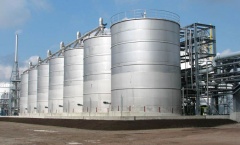Fermentation Alcohol
| Infobox on Fermentation Alcohol | |
|---|---|
| Example of Fermentation Alcohol |  |
| Facts | |
| Origin | - |
| Stowage factor (in m3/t) | - |
| Humidity / moisture | - |
| Ventilation | - |
| Risk factors | See text |
Fermentation Alcohol
Description / Application
The most common alcohols are ethyl, methyl and propyl alcohols (ethanol, methanol and propanol). Although methanol and propanol are mainly produced by the petrochemical industry, substantial amounts of ethanol are still produced by fermentation of starch. Ethanol is a colourless liquid freely miscible with water. In its original state it can be used as a fuel or a solvent (methylated spirits) but it is also an important raw material for chemical manufacture. Ethanol as well as the other alcohols can be oxidized to form aldehydes and then to carboxylic acids, with which they also react to form esters. In this way, acetic acids derived from ethanol for use as a solvent, and, by reaction with ethanol, to produce ethyl acetate. One common ester formed by cellulose and Acetic Acid is cellulose acetate, which is familiar as a thermoplastic moulding compound (telephones, packaging, film and buttons), as a man-made fibre (Tricel) and as a lacquer.
See also Ethyl Alcohol
Risk factors
For overseas carriage aspects of Chemicals, the readers are recommended to acquire or have access to a good chemical dictionary, and a copy of the International Maritime Dangerous Goods (IMDG) Code, issued by the International Maritime Organisation. Also consult the applicable MSDS sheet.











